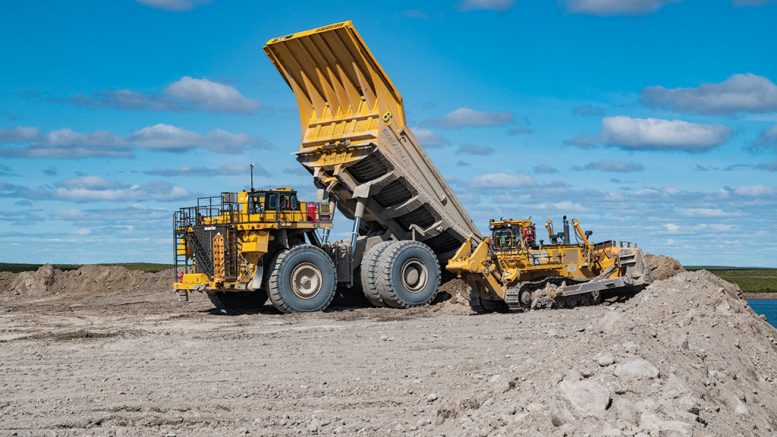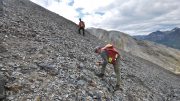While wider mining markets may have been subdued in 2018, mineral exploration in British Columbia, Yukon and the Northwest Territories continued to be a hotbed of activity, with junior and mid-tier companies advancing projects across the region. Here is a look at eight such companies.
ASCOT RESOURCES
Vancouver-based junior Ascot Resources (TSXV: AOT; US-OTC: AOTVF) is exploring for gold and silver in the Golden Triangle region of northwestern British Columbia.
The Derek White-led company’s flagship Premier gold project is in the southern part of the Triangle, north of Stewart, B.C., in an area with at least four past-producing mines. Ascot has focused most of its attention on Premier since 2014 and has spent more than $40 million in the region since 2007.

Ascot Resources’ president and CEO Derek White at the entrance to underground workings at the historic Premier mine at the Premier-Dilworth project in northwest British Columbia. Photo by Colin Desmond.
Ascot updated the resource estimate for Premier in December, with an increase in contained gold ounces. Total resources at Premier now stand at 2.8 million indicated tonnes grading 7.46 grams gold per tonne and 26.2 grams silver per tonne (for a contained 667,000 oz. gold and 2.3 million oz. silver), plus another 6 million inferred tonnes at 7.18 grams and 24 grams silver (contained 1.4 million oz. gold and 4.7 million oz. silver).
The resource includes high-grade zones from the Premier and Northern Lights, Big Missouri (including North Star, Province and Unicorn), Martha Ellen, Dilworth and Silver Coin areas. The outlines of these zones are modelled for a potential high-grade underground mine.
GROUP TEN METALS
Group Ten Metals (TSXV: PGE; US-OTC: PGEZF) is a junior explorer targeting the tenth group in the periodic table: nickel, palladium and platinum.
The Vancouver-based junior’s three main projects include its Stillwater West platinum group metals (PGM) project next to Sibanye-Stillwater’s Stillwater PGM mine in Montana; the Kluane PGM-nickel-copper project in the Yukon, by Nickel Creek Platinum’s world-class PGM deposit; and the Black Lake-Drayton gold project in northwestern Ontario’s Rainy River belt.

The team at Group Ten Metals’ Stillwater West PGM-nickel-copper project in Montana, from left: Mike Ostenson, geologist; Justin Modroo, geophysicist; Michael Rowley, president and CEO; Greg Johnson, executive chair; Craig Bow, chief geologist. Credit: Group Ten Metals.
In November, Group Ten raised $1.2 million in a private placement. Greg Johnson, chairman of Group Ten and the related Metallic Group of Companies, said: “We are pleased to complete the Group Ten financing, which was undertaken concurrently with independent private placements at the two other companies that make up the Metallic Group, being Metallic Minerals and Granite Creek Copper. In aggregate, the Metallic Group companies anticipate raising in excess of $3 million in new financing despite what continues to be challenging market conditions.”
In the Yukon, Group Ten Metals’ Kluane project consists of the Spy, Ultra and Catalyst properties, all of which occur within the Kluane mafic-ultramafic belt; a system of PGM-nickel-copper deposits which are part of a sequence of mafic-ultramafic rocks that extends through the Yukon from northern B.C. to central Alaska. The Kluane properties are each within 15 km of the Alaska Highway and situated on trend with, and south of, the Nickel Shaw (formerly Wellgreen) deposit — one of the largest undeveloped PGM-nickel-copper projects in North America.
JUGGERNAUT EXPLORATION
A recent financing effort by Vancouver-based gold junior Juggernaut Exploration (TSXV: JUGR; US-OTC: JUGRF) proved so popular, the company added a second tranche for total proceeds of $2.3 million.
The Dan Stuart-led company says it is now fully funded to carry out its 2019 exploration programs on its Empire, Midas, DSM and J2 projects — all located in northwestern British Columbia.
“Our properties are all located in key geologic terranes that have garnered interest from the miners and strong support from institutions alike,” Stuart said in a release. “Drill results from Midas and Empire will be reported once received, compiled and interpreted. We look forward to the 2019 drilling and exploration season with great anticipation.”
MOUNTAIN PROVINCE DIAMONDS
Mountain Province Diamonds (TSX: MPVD; NASDAQ: MPVD) and diamond major and operator De Beers are 49-51 co-owners of what the junior describes as “the world’s largest and richest new diamond mine” — namely the Gahcho Kué mine in the Northwest Territories.
According to guidance released in November, Mountain Province expects Gahcho Kué on a 100% basis in 2019 to process 3.1 million to 3.2 million tonnes of ore and recover 6.6 million to 6.9 million carats, and have production costs of $110 to $120 per tonne processed, or $50 to $54 per carat recovered — or virtually unchanged from 2018 production and cost levels.
Mountain Province says the partners’ production guidance from 2019 to 2021 shows a smooth mining rate, with steady performance. In the near-term, ore mined and processed for 2019 will mostly come from the Hearne pit, where mine expansion has unearthed various kimberlite facies.
The junior says 2018 was a “busy year for exploration” with the discovery of the intersection of kimberlite ore at depth between 5034 and Tuzo. It says in early 2019 drilling is ongoing to further delineate mineralization along these orebodies, and that it “has confidence in this project, and further potential success could improve the longer-term prospects for the Gahcho Kué Mine.”
NICKEL CREEK PLATINUM
Nickel Creek Platinum (TSX: NCP; US-OTC: NCPCF) — formerly Wellgreen Platinum — is focused on advancing its wholly owned Nickel Shaw project in the southwest corner of the Yukon, and says it could become “Canada’s next world-class nickel sulphide mine.”
The assets hosts over 2 billion lb. nickel, 1 billion lb. copper, 6 million oz. platinum group metals and 120 million lb. cobalt in the measured and indicated categories.

The camp at Nickel Creek Platinum’s Nickel Shaw polymetallic project in the Yukon. Credit: Nickel Creek Platinum.
A new management team was assembled in 2016–2017 (including bringing in former Romarco Minerals exec Diane Garrett as president and CEO), and a new technical team reanalyzed the deposit, and carried out more metallurgical studies.
In a September 2018 release, Nickel Creek noted that the project’s nickel-recovery correlates to sulphur, which lowers average nickel recoveries to levels below those observed in its second-phase metallurgical program.
“By applying the nickel sulphur recovery formula discussed above, the company estimates that the project’s 2017 stated mineral resource tonnage would be reduced by approximately 10%, using a nickel price of US$8.25 per pound. Given this new understanding, combined with current and projected long-term commodity prices and financial market conditions, the company believes it wouldn’t be prudent to complete a PEA until the emergence of improved financial market conditions and a stronger commodity price environment, and notionally not until nickel prices settle in the range of at least US$9 to US$11 per pound.”
SEABRIDGE GOLD
Toronto-based Seabridge Gold (TSX: SEA; NYSE: SA) has a 100% interest in four projects, with substantial resources of gold, copper and silver: KSM in northwestern B.C., Courageous Lake in the Northwest Territories, Iskut in B.C. and Snowstorm in Nevada.
KSM hosts a resource of 2.2 billion tonnes at 0.55 gram gold per tonne, 0.21% copper, 2.6 grams silver per tonne, 10.2 billion lb. copper and 183 million oz. silver, or 38.8 million oz. gold; while Courageous Lake has a resource of 91 million tonnes at 2.2 grams gold, or 6.5 million oz. gold.

Camp facilities at Seabridge Gold’s KSM copper-gold project in northwest British Columbia, where Tahltan Nation Development Corp. provides camp and catering services. Credit: Seabridge Gold.
Seabridge says the other drill holes done this year on the Iron Cap deposit at KSM “confirmed a northern down-plunge extension of the high-grade core zone originally discovered by Seabridge in 2016. Results include some exceptional widths of gold and copper mineralization, with grades exceeding the KSM resource average. Work is now in progress on an updated resource estimate for Iron Cap.”
In late 2018, Seabridge Gold raised $14 million in a private placement, and $3.5 million from exercised options. Proceeds are earmarked for general working capital requirements and a 2019 drill program at the Snowstorm gold project.
WHITE GOLD
White Gold (TSXV: WGO; US-OTC: WHGOF) owns a portfolio of 21,218 quartz claims across 34 properties, totalling 4,230 sq. km, in Yukon’s White Gold district, where 7 million oz. gold have been discovered this millennium.
That makes the Vancouver-based junior the district’s largest land holder, with 40% of the district.

The Yukon River in the White Gold district in the Yukon. Photo courtesy of Shawn Ryan.
It describes its properties as ranging from grassroots to advanced exploration, including its flagship White Gold property, with a resource of 961,000 oz. gold in the indicated category, plus 282,500 oz. gold in inferred.
White Gold recently found more high-grade gold mineralization outside of the previously drilled area on the Vertigo target at its JP Ross property in the Yukon, stepping out as much as 300 metres in multiple directions.
ZINCX RESOURCES
Vancouver-based ZincX Resources (TSXV: ZNX; US-OTC: CZXMF) says it is a mineral explorer focused on “unlocking the long-term mining potential of the zinc-lead-silver-enriched Kechika Trough district” in British Columbia.
Its says it is the “dominant tenure holder in the prolific Kechika Trough district” that is host to several zinc-lead-silver deposits, including the company’s Cardiac Creek deposit.
The company — formerly named Canada Zinc Metals Corp. — has divided its tenures into the Akie project, containing Cardiac Creek; and the Kechika regional project, with more grassroots assets.
ZincX says drilling on the Akie property since 2005 has identified a “significant body of baritic-zinc-lead SEDEX mineralization” known as the Cardiac Creek deposit, which is hosted by siliceous, carbonaceous, fine-grained clastic rocks of the Middle to Late Devonian Gunsteel Formation.
Over the last two months of 2018, ZincX raised gross proceeds of $1.39 million at a price of 39¢ per flow-through share.






Be the first to comment on "BC, Yukon & NWT Snapshot: Gold, base metals and diamonds remain top targets"